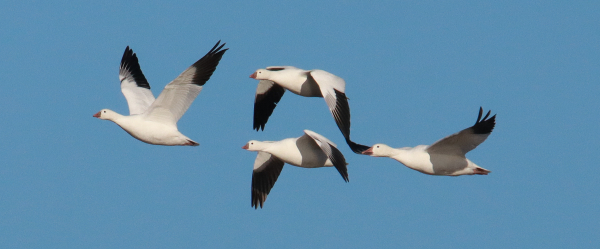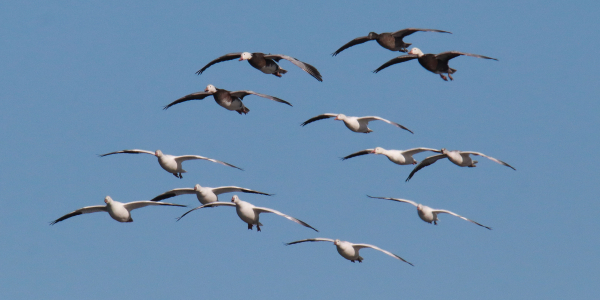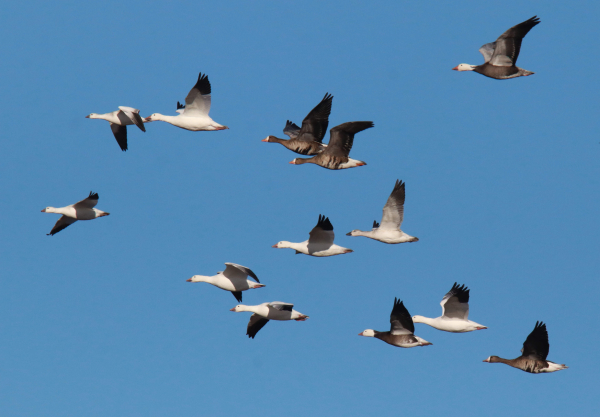Last week marked the beginning of the special time of late fall when the area surrounding my home is alive with goose music day and night, emanating from all directions as mega-flocks of Snow Geese mix with Ross’s Geese to cover broad expanses of area lakes and harvested cornfields. Miles of geese; thousands that add up to tens of thousands! Plus there are small flocks of White-fronted Geese, Cackling Geese, and Canada Geese – there are 5 species of geese in the area. The latter 3 species are now seen in small flocks, sometimes attached to an edge of a huge Snow Goose flock, or segregated into species-specific flocks and mixed species flocks.

This photograph shows the subtle differences between 3 Ross’s Geese and a Snow Goose, especially the differences in the size of their head, beak, and neck as well as their overall size. When standing, the size difference is even more obvious as Snow Geese tower over the smaller Ross’s Geese (600mm zoom lens, f-11 aperture, 1/3200 shutter speed, 800 ISO).
The diversity of species and their varied calls create an exciting aspect of the late fall goose action, but you soon notice there is even more variety among each species, which makes observing and photographing the geese so interesting. Even just among the Snow Geese, there are the obvious color morphs – white and blue. The white-colored Snows are dominant in the flocks, with blue morphs making up roughly between 30 and 40 percent of the Central Flyway populations that pass through my region of the Dakotas.

This line of Snow Geese provides a look at a white morph adult, flying behind a normal blue morph adult that is following 2 examples of hybrid adults with varying amounts of white belly plumage (600mm zoom lens, f-11 aperture, 1/3200 shutter speed, 800 ISO).
There are actually 2 more twists to the Snow Goose coloration story. First, the white and blue color morphs interbreed, creating interesting hybrids that resemble a mix of the 2 adults. Usually, these mixed geese resemble a blue morph Snow on their wings and anterior plumage, with a varying degree of white on their belly. Usually pure blue morph Snows have blue-gray belly plumage, but as some photos that illustrate this article show, the amount of white on their underside is variable among individuals. These blue geese with white undersides are particularly interesting to me – in the field and in photographs I take. In fact, some hybrids have extensive white plumage on their underside that may connect with white head plumage and in extreme cases may extend farther up along the sides of the individual.

A family group that includes 2 adult hybrid Snow Geese and their brood of 2 mostly blue morph juveniles. The young “blues” are beginning to molt some gray facial plumage that is being replaced with white feathers (600mm zoom lens, f-11 aperture, 1/2500 shutter speed, 800 ISO).
Another aspect of the plumages of Snow Geese is the distinctive juvenile plumage of white and blue morph birds. When you are close, you can see that first-fall white morph Snows have a light-gray blush to their white plumage that is a little darker on their head, neck, and back. Juvenile blue morph Snows are distinctly different, distinguished from adult blues and young white morphs by their almost uniform dark blue-gray plumage. And now, the young blue morph Snows are beginning to molt into their white head plumage, starting near the base of their beak and eventually continuing to include their head and neck; all while their body plumage is being replaced by darker blue adult plumage.
So that includes 5 primary looks for Snow Geese: White morph adults, blue morph adults, hybrid adults, juvenile white morphs, and juvenile blue morphs – all adding to the interest in photographing Snow Geese in flocks or family groups that show these 5 primary plumage types.

This interesting family group includes an adult pair made up of a white morph Snow Goose and a hybrid Snow with their apparent brood of 1 juvenile blue morph and 2 juvenile white morphs. The lead hybrid adult shows an extreme amount of white plumage that extends from its tail to its neck and up its sides (550mm zoom lens, f-11 aperture, 1/2500 shutter speed, 800 ISO).
Mixed among Snow Geese in varying numbers, Ross’s Geese add another twist to the variety seen in Snow Goose flocks. Ross’s Geese strongly resemble white morph Snow Geese, so much so that they are especially hard to distinguish in the field without the magnified aid of a binocular, spotting scope, or camera lens. The most obvious differences are the smaller size of Ross’s Geese, especially when you can compare the head, bill, and neck size and shapes, which are smaller and shorter. Juvenile Ross’s Geese look like the adults, but they have a light-gray coloration rather than the uniform bright white plumage. Very few blue morph Ross’s Geese have ever documented, so few that we can image that 99.99 percent of Ross’s Geese are white morphs.
There are 2 different plumages among White-fronted Geese, with juvenile plumage lacking any black horizontal lines across the belly, which is boldly indicative of adult White-fronts, although the number of black lines and the width and length tend to be an individual trait. Cackling Geese resemble miniature Canada Geese, almost similar to the differences between Ross’s and Snow Geese but sometimes more pronounced among the larger Canada subspecies. Some individuals and races among Canada and Cackling Geese can have a white neck ring of feathers, but there isn’t a clear difference between adults and juvenile plumages after August.

With their wings set in landing position under windless conditions, a mixed flock of Snow and Ross’s Geese glide down to join a growing concentration of geese on Church Lake. The aperture was changed to f-14 to expand the area in focus among the flock (600mm zoom lens, f-14 aperture, 1/2000 shutter speed, 800 ISO).
Having pointed out these interesting differences in the appearance among the 5 species of geese in the area, I like to try to photograph representatives of each of these species, age groups, color morphs, and hybrids. With that in mind, I enjoyed a special photography opportunity last Thursday morning when my first stop was only a mile south of home where a huge flock of Snow Geese was feeding with many Ross’s Geese mixed among them. I arrived just in time to witness small flocks beginning to break away to fly a quarter-mile to a second harvested cornfield. Flock after flock, and multiple flocks at a time provided a classic goose migration stopover feeding flight complete with beautiful morning sunlight and clear, fresh weather as the sounds of hundreds of Snow Geese sounded among the thousands concentrated in the huge flock.
Using my mobile blind, the geese permitted me to pick my spot, with the sun at my back and the geese flying low from north to southwest at just the right distance for my 150-to-600mm zoom lens to photograph during almost continuous flights of small flocks, family groups, and larger flocks up to about 40 geese, all without concern for the white car parked below. What fun I had, and what beautifully colored photographs I was producing fueled by perfect sunlight and the clear blue sky. This was the photo opportunity of the week, maybe the best photo session of fall for geese (but that’s yet to be determined).

By positioning at the top of a hill, I was able to take a different style of photograph of an expansive flock resting on the ice-covered surface of Herb’s Lake, although this image probably only shows 1/10th of this huge concentration of Snow and Ross’s Geese (320mm zoom lens, f-14 aperture, 1/1600 shutter speed, 800 ISO).
On the technical side of my photography, the light was so direct and so bright that the shutter speed was maxing out at 1/4000 second, so I dialed the aperture to a broad f-11 to be sure as many geese as possible would be in focus as they flew in broad formations, which worked out well. As geese lifted off the ground where they were feeding on kernels of corn, I watched for interesting groups that had a variety of different-looking birds without the aid of binoculars, then zeroed in on the more interesting looking geese that were flying in pleasing positions. This sometimes took a little patience, and a little anticipation, and some good luck too; although just being there with my camera was evidence of ample good luck.
When photographing flying birds, including flocks of birds, I like to take at least 2 photos in rapid succession to get a photo of birds with their wings raised high, then low, and sometimes I take a series of 3 to 5 photos when I think there is a special opportunity to get some special flight photographs. During this photo session I took lots of photographs, knowing this was a perfect photo opportunity due to the perfect lighting conditions while I was in an excellent position to photograph the geese. But I also took many photos just because it was so much fun – and that’s what I was there for, to enjoy the experience of documenting a spectacular event in nature during this special time of year. The next step would follow that evening, when I reviewed each photograph, selected images that had the potential to be worthy of publication, and those that stood out as fitting into an article such as this one.

A trio of White-fronted Geese are almost unnoticed in this flock that is led by an adult and juvenile Ross’s Geese and also includes 5 white morph and 2 blue morph adult Snow Geese, plus 1 juvenile white morph Snow (600mm zoom lens, f-11 aperture, 1/2500 shutter speed, 800 ISO).
After photographing to a point of saturation, I searched promising areas nearby and found 11 more huge flocks like this within a half-circle that measured15 miles west, southwest, south, and north, of which 3 huge flocks were within a mile of home! There is no real way of conveying the thrill of immersing yourself among one of the great avian concentrations in nature, and feeling the essence of an act of nature that recreates itself each fall and spring during migration at this central point in the continent. The sheer numbers of geese, and the magnificent views and volume of calls massed together are truly exhilarating. I hope you have an opportunity to get close to a huge feeding or resting flock of Snow Geese soon – it’s an act of nature that everyone should experience, camera in hand!
Article and Photographs by Paul Konrad
Share your bird photos and birding experiences at editorstbw2@gmail.com